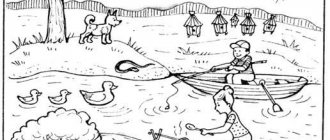Methodology for introducing children to the time sequence “Seasons”
Alla Mitapova
Methodology for introducing children to the time sequence “Seasons”
SLIDE 1
There is nothing more orderly than nature.
Cicero
Knowledge about seasonal changes in nature.
New personality-oriented tasks of education required a change in emphasis in organizing the activities of a preschooler. For a teacher in a preschool educational institution, the main thing is not the formal orientation towards the child achieving a specific result, but the possibility of his active inclusion in cognitive activity , nurturing his independence and initiative in performing any tasks, which leads to the development of the child’s activity itself, and therefore his personal development. Only thanks to the active emotional involvement of a preschooler in cognitive activity, new information becomes genuine knowledge for him, which in the future will be able to ensure his life in any situations and circumstances.
SLIDE 2
At preschool age, the following knowledge about changes in nature is available: each season has its own length of day and night, a certain type of weather, air temperature, typical precipitation; The characteristics of inanimate natural phenomena determine the state of the plant world and the way of life of animals in a given season.
Systematization of knowledge about seasons occurs on the basis of establishing temporary ones (what happens why)
and cause-and-effect
(from which certain phenomena occur)
relationships.
It is important to develop in children the ability to observe changes in natural phenomena, cultivate a sense of love for all living things, and teach some simple ways to protect nature.
SLIDE 3
General tasks:
- notice and highlight the characteristic features of the season;
- establish the simplest connections and dependencies between objects and
phenomena;
- acquire sufficient systematic knowledge about the life of animals and
plants.
SLIDE 4
Tasks should be specified depending on the age of the children , gradually expanding and becoming more complex.
First and second junior groups.
At this age, it is important that children accumulate knowledge, that is, specific ideas about individual objects of nature: about natural material and its properties. They are given the first knowledge of the distinctive features of the seasons. Younger preschoolers should understand some connections between natural phenomena.
Middle group
Children should know what phenomena are characteristic of each season , highlight some signs of the season, for example: fruits ripen in the fall, birds fly away, leaves fall. At the same age, children can already establish the simplest connections, for example: between the appearance of vegetables and fruits and their degree of ripeness, between the properties of snow and the state of the weather, between people’s work and the time of year .
The teacher leads the children to understand the dependence of animal life on the season and the need to create certain conditions for plant growth.
SLIDE 5
Senior group
Children should know and independently identify several characteristic signs of the season, features of its beginning and end, know the sequence of seasons ; establish a relationship between the state of inanimate nature, flora, labor and life of people.
SLIDE 6
Preparatory group
Children can already explain some causal, sequential and temporal relationships ; compare not only sharply different, but also initially similar “adjacent”
seasons, finding distinctive, similar and common features; when characterizing the season, they can identify signs of inanimate nature, flora and fauna, labor and life of people.
SLIDE 7
The educational process is not possible without a person-oriented approach to the education of preschool children, which implies an individual approach to each child. The advantages of person-centered learning include, first of all, attention to the child’s inner world, personal development through learning; secondly, the search for new methods , forms and means of teaching. A person-centered approach can be defined as a methodological orientation in pedagogical activity, which allows, by relying on a system of interrelated concepts, ideas and methods of action, to ensure and support the processes:
SLIDE 8
Techniques:
SLIDE 9
The teacher should strive not only and not so much to ensure that children have a certain number of ideas that are sufficiently deep and complete, but also be able to intelligently apply them in various activities.
SLIDE 10
preschool children
In kindergarten, various teaching methods (visual, practical, verbal)
.
methods are ways of joint activities between the teacher and children , during which the formation of knowledge, abilities and skills, as well as attitudes towards the world around them, is carried out. When introducing children to nature, these methods .
SLIDE 11
Visual methods include observation, looking at paintings, illustrations, demonstrating models, films, and presentations. Visual methods most fully correspond to the possibilities of cognitive activity of preschool children and allow them to form vivid, concrete ideas about nature.
SLIDE 12
Practical methods are games , elementary experiments and modeling. The use of these methods in the process of becoming familiar with nature allows the teacher to clarify children's , deepen them by establishing connections and relationships between individual objects and natural phenomena, systematize the acquired knowledge, and train preschoolers in applying knowledge.
SLIDE 13
Verbal methods include stories from the teacher and children , reading works of art about nature, conversations, and guessing riddles. Verbal methods are used to expand children's knowledge about nature , systematize and generalize it. Verbal methods help to form in children an emotionally positive attitude towards nature. When introducing children to nature, it is necessary to use different methods in a complex and correctly combine them with each other.
The choice of methods and the need for their integrated use are determined by the age capabilities of the children , the nature of the educational tasks that the teacher solves. The diversity of the objects and natural phenomena that a child must learn also requires the use of a variety of methods .
SLIDE 14
Observation as the main method of introducing children to nature .
Observation is a specially organized by the teacher, purposeful, more or less long-term and systematic, active perception by children of objects and natural phenomena.
The purpose of observation can be the assimilation of various knowledge - establishing the properties and qualities, structure and external structure of objects , reasons for the change and development of objects (plants, animals)
seasonal phenomena.
To successfully achieve the goal, the teacher thinks through and uses special techniques that organize the active perception of children : asks questions, offers to examine, compare objects with each other, establish connections between individual objects and natural phenomena.
Observation allows children to show nature in natural conditions in all its diversity, in the simplest, clearly presented relationships. Many connections and relationships of natural phenomena are accessible to direct observation and visible. Knowledge of connections and relationships forms the elements of a materialistic worldview of nature. The systematic use of observation in getting to know nature teaches children to look closely , notice its features and leads to the development of observation, and therefore, the solution of one of the most important tasks of mental education.
SLIDE 15
A good technique for developing observation skills is the technique of recording observations. This could be sketches in notebooks, coloring black and white drawings. You can make drawings from memory or from life. In this case, the teacher must demand that the drawing be as close as possible to the original. This forces children to carefully observe an object, peer into its details, notice details, and make repeated observations. One of the arguments for these objections is that children draw poorly. This circumstance should not be feared. It is not advisable to give up sketches for one more reason: drawing trains the hand and has a beneficial effect on the development of writing skills.
To form in children ideas about the diversity of plants and animals, objects of inanimate nature, to recognize the characteristics of certain objects, their properties, characteristics, qualities, recognizing observation . It ensures that children accumulate vivid , living knowledge about nature.
Observation can be carried out with individual children, with small groups (3-6 people), or with the entire group of pupils.
SLIDE 16
Depending on the number of children participating in the observation, it can be individual, group and frontal. Depending on the goals set by the teacher, observation can be episodic, long-term and final (generalizing)
.
Each subsequent observation must be related to the previous one. Thus, a system of knowledge, skills and abilities of children .
SLIDE 17
Conclusion
In a preschool institution, children are introduced to nature and the changes that occur in it at different times of the year . On the basis of acquired knowledge, such qualities as a realistic understanding of natural phenomena, curiosity , the ability to observe, think logically, and aesthetically relate to all living things are formed. Love of nature, skills of caring for it, caring for living beings give rise not only to interest in nature, but also contribute to the formation of the best character traits in children , such as patriotism, hard work, humanity, respect for the work of adults who protect and increase natural resources .
SLIDE 18
Nature took care of everything so much,
that everywhere you find something to learn.
Leonardo da Vinci
SLIDE 18 Thank you for your attention!
Visual game: seasons
Take four sheets of paper, preferably in different colors: white for winter, blue for spring, green for summer and yellow for autumn. An adult draws a tree with branches on each sheet. And then you need to transform each tree together with your baby, according to the seasons.
The winter one will be covered with a layer of white cotton wool or semolina like snow. In the spring, small green dotted leaves will appear, drawn with a cotton swab. The summer one will have large green leaves and flowers, which can be made from pre-dyed pasta or cut out from construction paper. Fall can be decorated with bright buttons or bright red and orange brush blots.
Advice:
First of all, you need to draw the child’s attention to how this or that season differs from another.
Winter.
It's cold, it's snowing. You can sled, ski and skate, and also make snowmen and play snowballs. We dress in warm clothes, wear mittens and hats with scarves. And in winter the New Year comes, and Grandfather Frost gives us gifts.
Spring.
Snow is melting. It is getting warmer. You can put your fur coat and mittens in the closet and put on a light jacket. The birds are returning. The first leaves and grass appear.
Summer.
It is hot outside. Everything is green, lots of flowers. We eat fruits and berries, swim and sunbathe. Everyone rides scooters and bicycles.
Autumn.
The leaves are turning yellow. The birds are flying away. It's getting cold and it's starting to rain. You need umbrellas, raincoats, rubber boots.
It is very convenient to teach the seasons, “starting” from the baby’s wardrobe. Together, put together a set of clothes to go outside in winter or summer. You can use dress-up games: paper dolls that change clothes (they can be magnetic or with Velcro).
When the first stage is mastered, it will be possible to tell in detail what is happening to nature, to water, what animals are doing. Get ready to answer a hundred thousand questions. A colorful children's encyclopedia will help you.
After you have talked about everything, it’s time to consolidate the material, and here you can’t do without games. For example, you can sort cards with pictures by season, or name what people do in the fall and what in the spring.
You can prepare 4 small boxes, decorate them beautifully and, together with your baby, fill the boxes with “memories” of summer, autumn, winter and spring. Sort out your family photo archive and make a “calendar” of photos. The baby will see how he himself looked in the fall and spring, what he was wearing and what he did outside in winter and summer.
Draw your child’s attention to changes outside the window more often. Explain that it can rain in summer, and that the sun shines in winter, but it does not warm. Tell your child as much as possible about the world around him and answer all his questions, and then soon he will not confuse winter with spring, and summer with autumn. And after a little more time he will be able to list all the months of the year, and in the correct order!
Advice:
It makes sense to teach your child the months of the year no earlier than 4-4.5 years. Of course, it’s difficult for kids to understand a month as a period of time, so at first it will just be encyclopedic knowledge.
One of the most effective ways to learn about the seasons is to associate each of them with a holiday. So, winter is New Year, spring is March 8, summer is vacation, autumn is Knowledge Day. And it will be easy for the child to remember the season and month when his birthday is celebrated.




